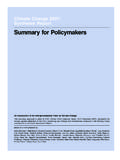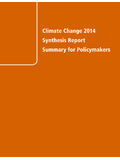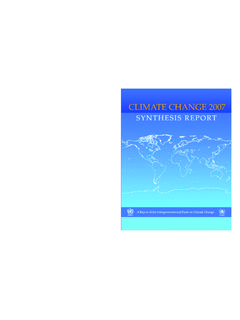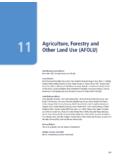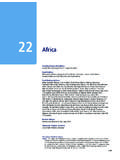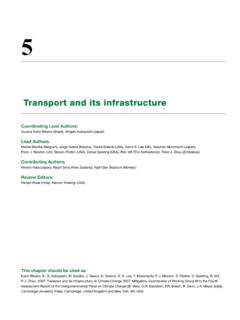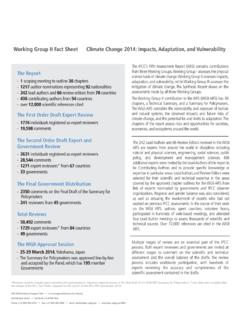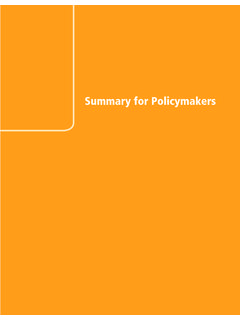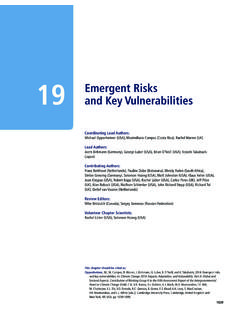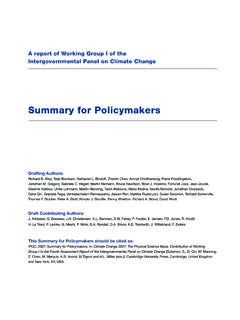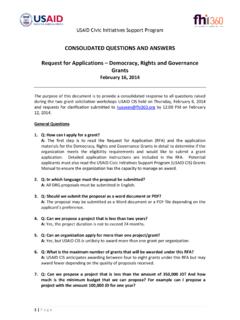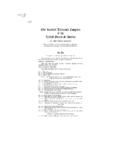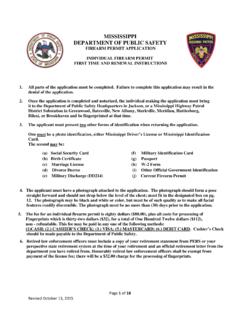Transcription of SPM1 Summary for Policymakers - IPCC
1 31 This Summary for Policymakers should be cited as:IPCC, 2013: Summary for Policymakers . In: Climate Change 2013: The Physical Science Basis. Contribution of Working Group I to the Fifth Assessment Report of the Intergovernmental Panel on Climate Change [Stocker, , D. Qin, Plattner, M. Tignor, Allen, J. Boschung, A. Nauels, Y. Xia, V. Bex and Midgley (eds.)]. Cambridge University Press, Cambridge, United Kingdom and New York, NY, for PolicymakersSPMD rafting Authors:Lisa V.
2 Alexander (Australia), Simon K. Allen (Switzerland/New Zealand), Nathaniel L. Bindoff (Australia), Fran ois-Marie Br on (France), John A. Church (Australia), Ulrich Cubasch (Germany), Seita Emori (Japan), Piers Forster (UK), Pierre Friedlingstein (UK/Belgium), Nathan Gillett (Canada), Jonathan M. Gregory (UK), Dennis L. Hartmann (USA), Eystein Jansen (Norway), Ben Kirtman (USA), Reto Knutti (Switzerland), Krishna Kumar Kanikicharla (India), Peter Lemke (Germany), Jochem Marotzke (Germany), Val rie Masson-Delmotte (France), Gerald A.
3 Meehl (USA), Igor I. Mokhov (Russian Federation), Shilong Piao (China), Gian-Kasper Plattner (Switzerland), Qin Dahe (China), Venkatachalam Ramaswamy (USA), David Randall (USA), Monika Rhein (Germany), Maisa Rojas (Chile), Christopher Sabine (USA), Drew Shindell (USA), Thomas F. Stocker (Switzerland), Lynne D. Talley (USA), David G. Vaughan (UK), Shang-Ping Xie (USA)Draft Contributing Authors:Myles R. Allen (UK), Olivier Boucher (France), Don Chambers (USA), Jens Hesselbjerg Christensen (Denmark), Philippe Ciais (France), Peter U.
4 Clark (USA), Matthew Collins (UK), Josefino C. Comiso (USA), Viviane Vasconcellos de Menezes (Australia/Brazil), Richard A. Feely (USA), Thierry Fichefet (Belgium), Arlene M. Fiore (USA), Gregory Flato (Canada), Jan Fuglestvedt (Norway), Gabriele Hegerl (UK/Germany), Paul J. Hezel (Belgium/USA), Gregory C. Johnson (USA), Georg Kaser (Austria/Italy), Vladimir Kattsov (Russian Federation), John Kennedy (UK), Albert M. G. Klein Tank (Netherlands), Corinne Le Qu r (UK), Gunnar Myhre (Norway), Timothy Osborn (UK), Antony J.
5 Payne (UK), Judith Perlwitz (USA), Scott Power (Australia), Michael Prather (USA), Stephen R. Rintoul (Australia), Joeri Rogelj (Switzerland/Belgium), Matilde Rusticucci (Argentina), Michael Schulz (Germany), Jan Sedl ek (Switzerland), Peter A. Stott (UK), Rowan Sutton (UK), Peter W. Thorne (USA/Norway/UK), Donald Wuebbles (USA)SPMS ummary for Policymakers41 In this Summary for Policymakers , the following Summary terms are used to describe the available evidence: limited, medium, or robust; and for the degree of agreement: low, medium, or high.
6 A level of confidence is expressed using five qualifiers: very low, low, medium, high, and very high, and typeset in italics, , medium confidence. For a given evidence and agreement statement, different confidence levels can be assigned, but increasing levels of evidence and degrees of agreement are correlated with increasing confidence (see Chapter 1 and Box for more details).2 In this Summary for Policymakers , the following terms have been used to indicate the assessed likelihood of an outcome or a result: virtually certain 99 100% probability, very likely 90 100%, likely 66 100%, about as likely as not 33 66%, unlikely 0 33%, very unlikely 0 10%, exceptionally unlikely 0 1%.
7 Additional terms (extremely likely: 95 100%, more likely than not >50 100%, and extremely unlikely 0 5%) may also be used when appropriate. Assessed likelihood is typeset in italics, , very likely (see Chapter 1 and Box for more details).Warming of the climate system is unequivocal, and since the 1950s, many of the observed changes are unprecedented over decades to millennia. The atmosphere and ocean have warmed, the amounts of snow and ice have diminished, sea level has risen, and the concentrations of greenhouse gases have increased (see Figures , , and ).
8 { , , , , , , , , , }A. IntroductionThe Working Group I contribution to the IPCC s Fifth Assessment Report (AR5) considers new evidence of climate change based on many independent scientific analyses from observations of the climate system, paleoclimate archives, theoretical studies of climate processes and simulations using climate models. It builds upon the Working Group I contribution to the IPCC s Fourth Assessment Report (AR4), and incorporates subsequent new findings of research. As a component of the fifth assessment cycle, the IPCC Special Report on Managing the Risks of Extreme Events and Disasters to Advance Climate Change Adaptation (SREX) is an important basis for information on changing weather and climate Summary for Policymakers (SPM) follows the structure of the Working Group I report.
9 The narrative is supported by a series of overarching highlighted conclusions which, taken together, provide a concise Summary . Main sections are introduced with a brief paragraph in italics which outlines the methodological basis of the degree of certainty in key findings in this assessment is based on the author teams evaluations of underlying scientific understanding and is expressed as a qualitative level of confidence (from very low to very high) and, when possible, probabilistically with a quantified likelihood (from exceptionally unlikely to virtually certain).
10 Confidence in the validity of a finding is based on the type, amount, quality, and consistency of evidence ( , data, mechanistic understanding, theory, models, expert judgment) and the degree of agreement1. Probabilistic estimates of quantified measures of uncertainty in a finding are based on statistical analysis of observations or model results, or both, and expert judgment2. Where appropriate, findings are also formulated as statements of fact without using uncertainty qualifiers. (See Chapter 1 and Box for more details about the specific language the IPCC uses to communicate uncertainty).
